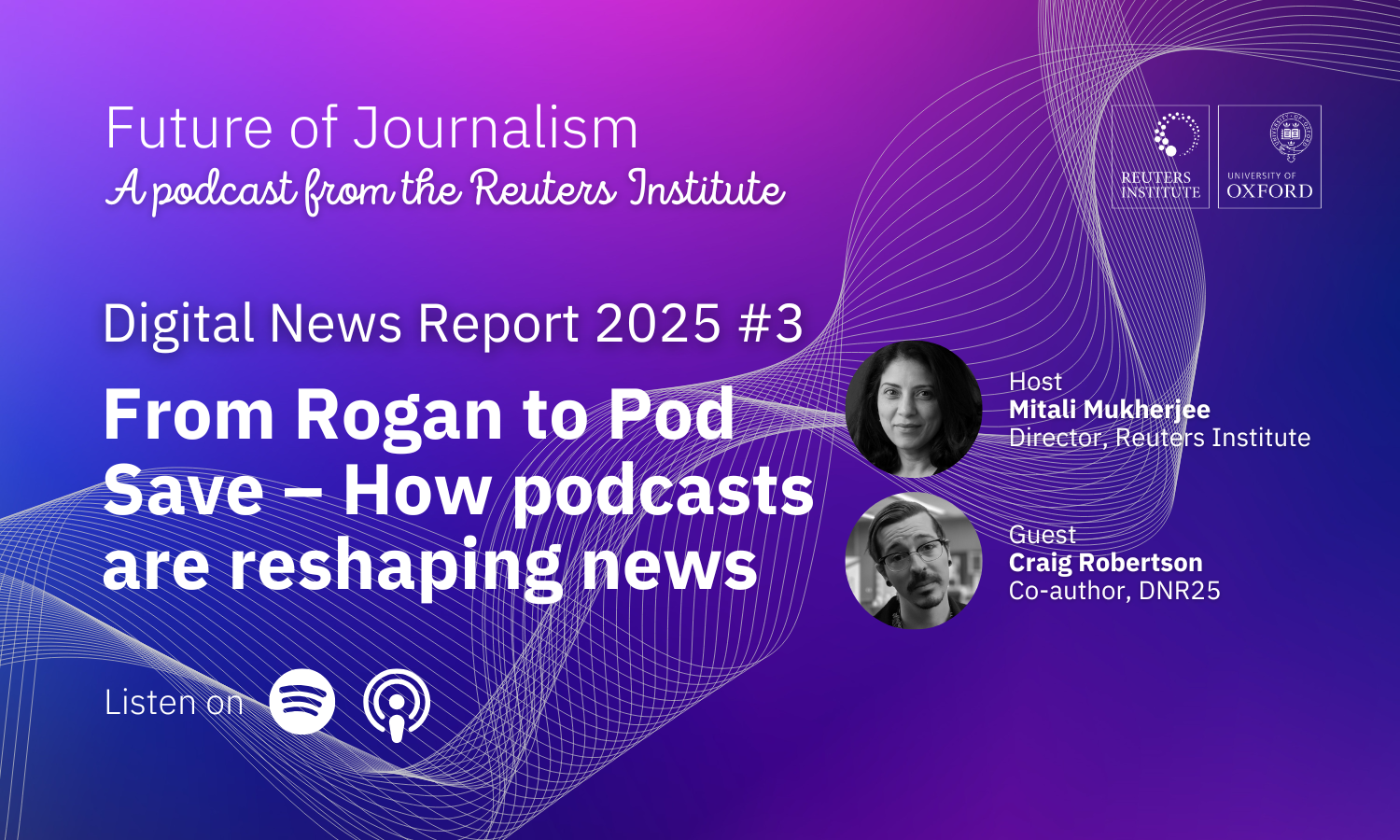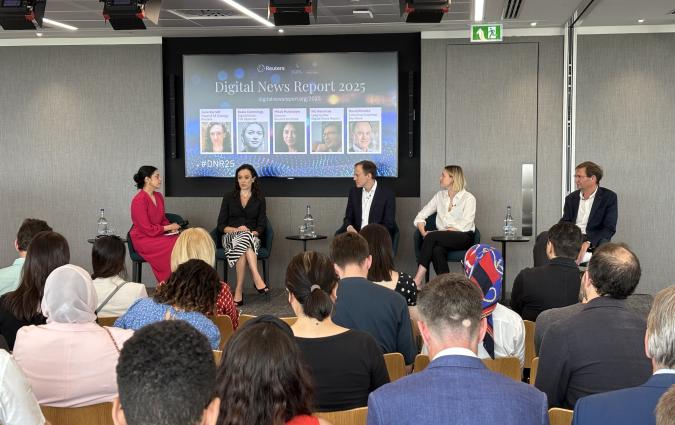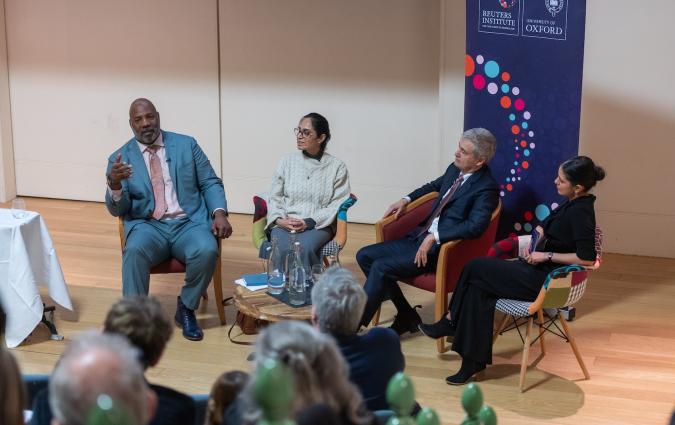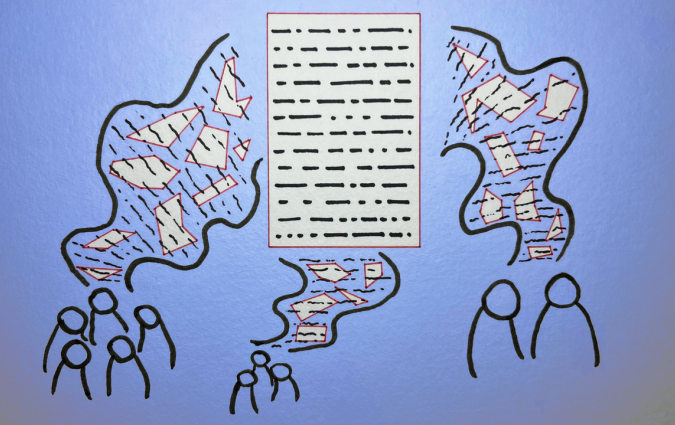Our podcast: Digital News Report 2025. Episode 3: From Rogan to Pod Save – How podcasts are reshaping news

What is a news podcast nowadays? Some light entertainment podcasts discuss news, while a format designed for audio is thriving on visual platforms like YouTube. In this episode of Future of Journalism, we look at levels of podcast consumption worldwide, what audiences say are their favourite podcasts, where they're being listened to and trends across countries. We also look at the favoured platforms for listening, and how news publishers are using them for monetisation and engagement.
The speakers
Craig T. Robertson is a postdoctoral research fellow at the Reuters Institute for the Study of Journalism. His research focus includes news trust and credibility, fact-checking and verification, and how both partisan attitudes and epistemic beliefs factor into these domains. He is a co-author of the Digital News Report.
Host Mitali Mukherjee is the Director of the Reuters Institute and is a political economy journalist with more than two decades of experience in TV, print and digital journalism.
Transcript
Podcasts in the news ecosystem | Who’s listening to podcasts | The most popular podcasts and platforms | How people consume podcasts | Audience engagement and revenue | Takeaways for news publishers
Podcasts in the news landscape
Mitali: Craig, how has, and I suppose I should start with has, podcasting become a central part of the news publishing landscape?
Craig: So podcasting is in an interesting space right now, like it feels new, but people have been making podcasts since around 2004 so that means podcasts actually predate the iPhone. And I'm not sure actually how long news publishers have been making them, exactly, but it's obviously been a while, but slowly over time, I think they've become more important because of the relationship that people have to podcasts, people tend to be loyal listeners and come back over and over again, so they're a good avenue for publishers seeking to build a relationship with audiences and encourage loyalty. They've also become an important format because it's a format that's useful to tell one or two stories in a short, convenient format. So that's become more appealing to people because there's just so much news content out there, it's really hard for people to navigate it. So many people just want to know, what are the two, three, four most important things they need to know for the day without all the extra clutter. So podcasts are a good format for that. So I think that's also part of why publishers have leaned into them.
Mitali: Let's lift the hood a little bit and talk to us. You know about the thoughts you had while exploring this chapter? Were there particular aspects that you wanted to focus on in particular this year?
Craig: So yeah, in this chapter, as you mentioned, we wanted to hone in on a few things fuelling the newer developments in the podcasting world. One of those things is video podcasts. It seemed like such a strange thing to me a few years ago, since I've been listening to podcasts for years, but I never really watched any podcast. But this seems to be a huge thing. Now, people watch Joe Rogan's podcast on YouTube, they’re a huge genre on platforms like TikTok. So we wanted to take a look at that. Interestingly enough, the most popular platform to engage with podcasts in the US is YouTube. So that's really fascinating. And then the other aspect we wanted to focus on, which is of key relevance to news publishers, is the monetisation of podcasts, or the potential there for monetisation. So what strategies are being adopted? What strategies might be appealing to audiences? It's a developing space, so it's not yet to be seen. What works the best
Mitali: Is there a clear watermark, though, Craig, when you sort of benchmark this across countries in terms of overall consumption levels of news podcasts, or conversely, do you see great variation from one country to another.
Craig: Now, overall, the broad picture across all our markets, podcast listening particularly for news, is still quite a niche activity. So across a basket of 20 countries we've been tracking over time for podcasts listening, we have 9% of people using podcasts for news, so it's a small amount. We focus on a subset of 20 markets where we think the term podcast is well understood. But as we'll talk about, the definition of what is a podcast seems to be a bit blurry now, but overall it's a small number of people consuming news podcasts in comparison to other ways of accessing using social media, TV. So it's 9% overall, but this increases to 15% for people in the US using podcasts for news. In the UK, it's just 7% so there is variation, but it's not a very large variation. It's sort of a small variation about a small number.
Who’s listening to news podcasts
Mitali: Really a big event for the US, though, in terms of how news podcasts are moving the dial there, and anything in terms of the type of audiences that we're looking at. Craig, I know you mentioned that it's niche, but is there a particular subset, when you look at the audiences drawn towards podcasts?
Craig: Yeah, this is where it's interesting, and this is why, despite it being somewhat of a niche area, news publishers have been leaning into podcasts so heavily. It's about who is listening. So podcast listeners tend to be younger, better educated, have higher incomes than non-listeners. So that's exactly the kind of audience publishers want to reach. News outlets have been struggling, obviously, in recent years, to reach younger audiences. Podcasts might help with that. News outlets have also had difficulty generating revenue. Loyal podcast listeners who have higher incomes might help with that. So you might be able to convince some of these listeners to sign up for a subscription or pay for news in some other way so they fit into the overall business strategy of many news outlets.
The most popular news podcasts and platforms
Mitali: Let's look at your chapter, Craig, and the three markets you focus on, which is Norway, the UK and the US. And it's quite fascinating, because of how different the tone antenna is in terms of, you know, what's working in these markets. You know, do a little bit of a comparison for us. What did you find in these three key markets?
Craig: So we've published a list of the most mentioned podcasts across these three markets. We asked people to name the podcast they listened to, and we compiled lists of the ones that were most mentioned. Full disclosure, I haven't actually listened to some of the top podcasts we found in our research. I am personally a heavy podcast listener. It's probably my main source of news. So my personal go tos are ‘The Daily’ by the New York Times, ‘Today in Focus’, from The Guardian, ‘Start Here’, from ABC and ‘The Journal’, from the Wall Street Journal, and then some sort of specific tech focus podcasts like the ‘404 Media Podcast’ and ‘The Vergecast’.
As for other people, those we asked in the survey, we counted out all the most mentioned names, and you get some really interesting differences across countries. So in the UK, it's these very sober, analytical politics, news focused podcasts. You've got political and news analysis shows from the ‘Rest is Politics’ and ‘The News Agents’. You've got your BBC podcasts in there of course, you've got ‘Newscast’, ‘Americast’, and also, interestingly, a somewhat lighter politics news show with ‘Pod Save the UK’, which features comedian Nish Kumar. Most of these are quite conversational, quite down the middle politically, a bit left leaning for some of the other shows, like ‘Pod Save the UK’, but nowhere like what we see in the US. So that's probably the major difference that we see with the US. It's very popular heavily partisan shows. These are shows born out about out of outlets like the Daily Wire with Candace Owens and Ben Shapiro. These podcasts, especially on the right, have become quite politically influential on the American right, Donald Trump was appearing on a bunch of them in the lead up to the 2024 election. So definitely seeing them as an avenue to reach audiences outside the mainstream media. Joe Rogan is also in the mix there in the US, though his audience actually seems to cut across the political spectrum. He reaches people on the left and the right. And in terms of left leaning podcasts on our American list, I'd say we have ‘Pod Save America’, which is the originator of the ‘Pod Save The UK’, which spun off from that. And then there's the ‘MeidasTouch Podcast’, which comes from the popular MeidasTouch network whose home I believe is on YouTube. And as for Norway, I can't speak Norwegian, so I can't say much about the content of the shows, but from what we know about who's producing the shows, it's a solid that they are closer in style and tone to the UK shows. So these are shows from public broadcaster NRK, the newspaper Aftenposten and the tabloid VG, so none of these influences or creators like in the US, it's shows from established media brands in Norway.
Mitali: I feel like we should have a side event on the DNR team and who's listening to what podcasts. That's sort of an interesting subset in itself. But let's talk about what's happening with some of the established news outlets, because they have become, as you said, pretty major players in the podcast space. How is that stacking up against established platforms like Spotify or Apple podcasts?
Craig: It really depends where you look. NRK radio, the app that you'd use in Norway to listen to NRK shows, that's the most popular podcast platform in Norway. Almost two thirds of podcast listeners are using it in Norway, and then just under half are using Spotify in the UK.
It's a bit of a three way split between Spotify, the BBC Sounds app, and YouTube. So those are the three main platforms for podcast listening in the UK, you have just over a third of listeners to podcasts using BBC Sounds, just behind Spotify, with 41% of people using it for podcasts. So Spotify in the UK is the main source. And besides the public broadcasters in Norway and UK, there's only a small subset of people using other news outlets, apps, but obviously there's potential for growth there.
The US is again a different story, so the main platform for podcasts in the US, as I mentioned, is YouTube, and it's completely unclear to me, and it's unclear from our data, how many people are actually watching versus listening when they're on YouTube. You can obviously do both. So YouTube is a top platform used by around half of our American podcast listeners. And then you have nearly 40% of people using Spotify. And then obviously that's 10 percentage points behind YouTube. So compared to the UK and Norway, you have around 13% of people using the NPR app for podcasts. So again, a smaller subset, and definitely a much smaller subset when you compare to BBC Sounds or NRK. But yeah, the story in the US is YouTube, and it's very fascinating.
How people consume news podcasts
Mitali: Yeah, let's talk about that. As you said, that's where it sort of really takes many interesting twists and turns. Are you listening? Are you watching? Are you doing both? Where is that fall in terms of categorisation and just picking up from the US? Is that a reflection of just how the form and shape of podcasts is changing? Where people see value in engaging with this media, both as a visual product, but also as an audio product.
Craig: Yeah, it's a developing space. A few years ago in our data, when I noticed that YouTube was really popular for podcasts, because we asked these kinds of questions every so often to repeat and get comparisons, I noticed YouTube was very popular for podcasts, and I was confused, because I'm a very traditional listener. It's my phone, my headphones, I listen. But we've seen this growing trend, and I think it's largely a trend coming out of the entertainment space where people are filming their podcast now and then they're being put on YouTube or they're being cut up and their clips are being put on Tiktok and Instagram. So it's actually a useful way to market podcasts, since the visual element makes it easier to reach people on other platforms, it doesn't work as well if it's just an audio file.
And as I said Joe Rogan gets millions upon millions of views on some of his podcast episodes, people watching him on YouTube, and some of those interviews make news. But at the moment, it seems to be predominantly in the entertainment space. It's comedians, lifestyle influencers. People were doing chat shows and interview shows. And actually, when we asked audiences in you know, the US, Norway, UK, why they watch podcasts, if they did at all. They said it was getting those visual aspects. So seeing a person's reaction to a question, seeing their body language, someone even said that they like to see what the hosts or guests were wearing. So I guess you're very much in the lifestyle space. When it came to news, there wasn't as much pickup or enthusiasm, and it's largely because, you know, what's the add-on benefit of visuals for a news podcast, people didn't feel as much of a need to see the host.
Plus the way that people listen matters. So podcasts, especially news podcasts, are fitting into people's routines where a screen just gets in the way, or where you're legally not supposed to be looking at a screen while, like, driving a car. So podcast listeners, the news podcast listeners, talked about routines, podcasts fitting into them, like listening while cooking, while going to the gym, while going to work. That's where podcasts fit into their lives, and video didn't really suit that. In that sense, video requires an event, sitting down and looking. Plus, there was actually a pretty funny and accurate comment from someone in Norway who said, you know, ‘if I'm going to watch a news podcast at that point, am I not just watching TV?’ I might as well just turn the TV on. So overall, not as much pickup for video podcasts when it came to news, but we'll see. Maybe someone will crack the formula or come up with a model that works for news and gets people tuning in. We're seeing popularity for some news podcasts on YouTube. So as I mentioned, the independent producers, MeidasTouch, they're popular on YouTube. So there is a way to do it, but we'll see in the future. You know, what happens with all that?
Audience engagement and revenue
Mitali: It's like the joke, Craig, where, if you're watching a video and you see a big black mic, then you know it's a podcast, and that's the differentiator. But let's sort of turn the lens of the question from the audience to news publishers. Is there value? What do news publishers gain from sort of turning podcasts into video or exploring that idea.
Craig: I mean, one very obvious simple thing is, like advertising, as I mentioned, it's, how do you get your show in front of people? So a lot of podcasts tend to spread, you know, word of mouth. You tell your friends, your family about this podcast, and they start listening as well. But, you know, you can't, sort of engineer that. But doing video podcasts allows you, as I mentioned, to reach people on platforms like Tiktok and Instagram. You can cut up your clips, put them in the vertical format, and then hope you can cultivate an audience that way. The other thing is, I'm guessing, deepening that connection with the audience. You know, if you have a popular host that people like, they might want to watch that host and get to know them better. So you get a bit more out of seeing that person, their expressions, their body language. There's more of that connection. So again, fostering that loyalty to the brand.
Mitali: One of the threads we have continually pointed to in the Digital News Report is more and more news avoiders Craig or people basically turning away from the news. So let's examine the pros and cons of the podcast model a little bit. As you said, it's quite a niche audience. What do news publishers stand to gain from continuing to keep that focus alive on podcasts as an offering.
Craig: So yeah, as I mentioned, I think it's primarily in many ways about loyalty. You want people coming back. You want people to like your brand, to consume your news, and that's the most straightforward answer. When you talk about podcast listeners, they mention that loyalty, returning to the same shows, really connecting to the hosts, listening habitually. And that's the ideal. When you run a business, you want people coming back, and that's part of the story of why podcasts have become important to news publishers, because if you have these loyal listeners, you might end up having a loyal subscriber.
Mitali: And it's clear, and there is, you know, an overwhelming majority saying that they will not pay for the news. Maybe it's a little bit different for podcasts, but not a lot. And what could persuade those who don't pay to actually do that, to access a podcast of their choice and liking?
Craig: So, yeah, getting people to pay for news, the trickiest thing of all. We know from years of doing our research that this is hard. People are used to free news, used to free podcasts, and budging those people who don't pay. It's a very difficult thing, but news podcast listeners are actually interesting. They seem more open to paying. So we asked a question in the survey about this, and there was some more openness than we would tend to see for people willing to pay for podcasts that they like, or news podcasts specifically. And it comes down to the main things that people say when they went into what they like about news podcasts. So one thing was depth and understanding. People liked news podcasts because they felt they got a lot they got a deeper understanding of stories. That's what they valued about them. So if there was exclusive add-on content that offered them more depth and insight, there was a willingness to pay there. The second major thing that people mentioned was uniqueness and exclusivity. You want to be paying for something that adds value to your life, add something extra, whether that's exclusive interviews with interesting people, bonus content, that kind of stuff makes it feel worth paying for. I have to mention, though, that people were not very keen on the idea of their favorite podcast just suddenly going behind a paywall. It was, you know, keep the main offering free, do ads and sponsorships. That's all fine with everyone, and then maybe add some additional subscriber only content on top.
Mitali: It's clear from our conversation and from your findings as well, Craig, that it's quite a different mood meter across different regions and how people are consuming these podcasts. Are there sort of key highlights to take away for news publishers, common themes or common checks that they could use in their own podcast offerings.
Craig: Replicating a Joe Rogan, I don't know if they're going to get that. I mean, it's possible to become very, very popular, but it's not a guarantee. You can't rest just on getting a popular host, I think, for a news podcast based on our interviews and our research, it's about leaning into what they do best and what people see them as being useful for. They want depth, they want understanding, and they want insight, and they also want convenience. So it's about providing content that fits into the routines of people's lives. You know, top stories in the morning for people on their way to work, analysis and insights from people on their lunch break, perhaps a bit of a lighter, deep dive into less serious topics in the afternoon or evening. It's that kind of thing providing people the things that they need throughout all these periods of the day. Yeah, but that said, there's no one-size-fits-all strategy. There never is. So I guess it's about testing out different things and seeing what works. You might be able to capitalise on a popular host and build out from there, or you might gather together a few podcast shows that serve different needs and offer cover different topics and then offer those as a bundle, for example, that's what the New York Times is doing. So yeah, there's different ways. It's just about testing out what works, I guess.
Mitali: It’s a fascinating space. And thank you, Craig for joining our podcast today and sharing all these findings with us.
Listen to the whole series
In every email we send you'll find original reporting, evidence-based insights, online seminars and readings curated from 100s of sources - all in 5 minutes.
- Twice a week
- More than 20,000 people receive it
- Unsubscribe any time






